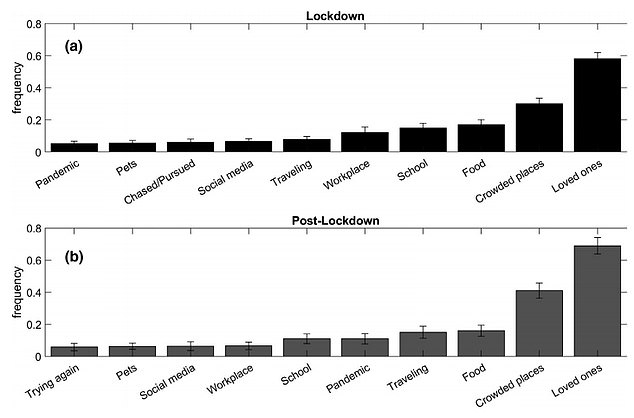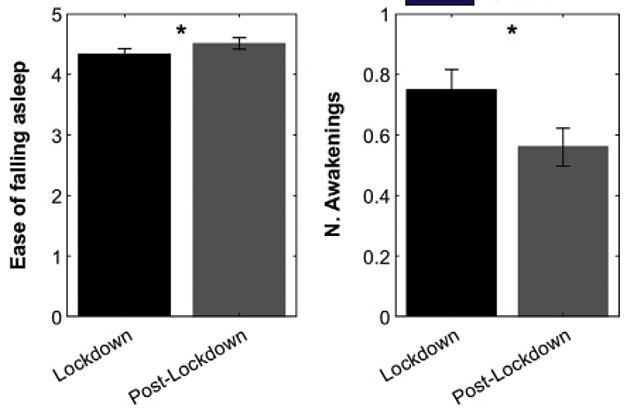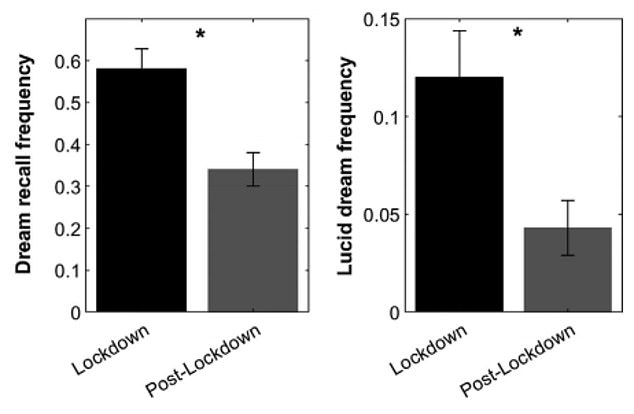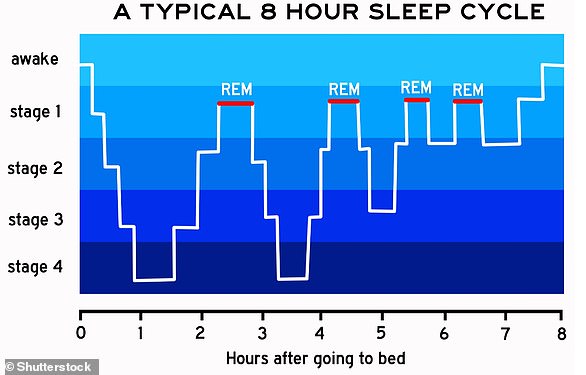Nightmares about being stuck in crowded places are more common when people are in lockdown, a small study has suggested.
People also had a harder time falling asleep and woke up more often when they were under strict restrictions compared to when curbs were eased.
Researchers in Italy surveyed 90 people in the week ending May 4 — during the country’s first lockdown — and the week ending May 11, when it was lifted.
They asked people to record their dreams at home, and complete a sleep diary each morning.
In general, they found people’s quality of sleep was worse in lockdown — a trend that has been mirrored in dozens of studies.
People experienced more dreams and nightmares about crowds after the nationwide shutdown, the University of Rome researchers also found.
The pandemic may have changed people’s sleeping habits due to ‘collective trauma’ – similarly to when people’s dreams became more intense following the 9/11 terrorist attack.

People are having more nightmares about being in crowded places since Covid lockdowns ended, a study in Italy has shown

Research looking at 90 adults in Italy for two weeks between April and May last year showed people had a harder time falling asleep and woke up more often during lockdowns

Participants also remembered their dreams with more clarity during lockdown and had more lucid dreams — when people experience a state of heightened awareness during sleep that allows them to recognise the dream and control what happens within it
The authors, led by Serena Scarpelli, said the survey showed a significant difference between quality of sleep and dream content under pandemic restrictions and without them.
They wrote: ‘The coronavirus 2019 outbreak critically impacted the worldwide population.
‘In the first phase of the pandemic, Italy was one of the most affected countries, and the government quickly adopted restrictive measures between March and May 2020 to contain the infection.
‘Confinement and social distancing provoked remarkable daily life changes that significantly influenced sleep patterns.
‘Our results confirmed both sleep and dream measures showed critical differences between lockdown and post-lockdown periods.’
The study, published in the Journal of Sleep and Research, included 72 women and 18 men aged 19 to 41.
They recruited participants on social media and the majority were students — 50 out of 90.
People were told to dictate their dream experiences into a tape recorder 15 minutes after waking every morning during the two weeks studied.
Participants then filled out a dream diary ranking their ease of falling asleep (one to six), the number of awakenings during the night, what time they fell asleep and when they woke up.
They were also asked the number of dreams they remembered, how vivid memories were and how bizarre or emotionally intense they perceived the dreams to be.
Researchers found the most common dreams were about loved ones, with crowded places the second most frequent both during lockdown and after it. But they were about a third more frequent post-lockdown.
Participants dreamt more about food, travelling and the pandemic once restrictions had been lifted.
Volunteers also remembered their dreams with more clarity during Italy’s lockdown, the study revealed.
Strong dream recall has often been linked to traumatic events, and the researchers claimed it reaffirms the idea that the pandemic caused ‘collective trauma’.
Data also showed people had more lucid dreams — when people experience a state of heightened awareness during sleep that allows them to recognise the dream and control what happens within it — during lockdowns.
Experts said this ‘could reflect the attempt to cope with the waking pandemic-experiences’.
People found it slightly harder to fall asleep during lockdown, which experts said was caused by higher levels of anxiety.
More than half the respondents showed clinically relevant anxiety and PTSD-related symptoms during sleep during lockdown, the study found.
The authors said the higher proportion of women in the study may have biased results, with more women having reported sleeping difficulties during the pandemic in previous studies.
THE FOUR STAGES OF SLEEP 
Pictured, different steps of the night sleep cycle. Most dreaming occurs during REM sleep (marked in red) although some can also occur in non-REM sleep
Sleep is generally separated in four stages. The first three of these are known as ‘non rapid eye movement’ or NREM sleep.
The last stage is known as rapid eye movement or REM sleep.
A typical night’s sleep goes back and forth between the stages.
Stage 1: In the first five minutes or so after dropping off we are not deeply asleep.
We are still aware of our surroundings but our muscles start to relax, the heart beat slows down and brainwave patterns, known as theta waves, become irregular but rapid.
Although we are asleep during Stage 1, we may wake up from it feeling like we didn’t sleep at all.
After around five minutes our bodies move into stage two.
Stage 2: This is when we have drifted into sleep, and if awakened would know you we been asleep. Waking up is still fairly easy.
This stage is identified by short bursts of electrical activity in the brain known as spindles, and larger waves known as K-complexes, which indicate that the brain is still aware of what is going on around it before turning off to a sub-conscious level.
Heartbeat and breathing is slow, and muscles relax even further.
Our body temperature drops and eye movements stop.
Brain wave activity slows but is marked by brief bursts of electrical activity.
Stage 3: Stage 3 non-REM sleep is the period of deep sleep that we need to feel refreshed in the morning.
It occurs in longer periods during the first half of the night.
Our heartbeat and breathing slow to their lowest levels during sleep and brain waves become even slower.
Our muscles are relaxed and it people may find it difficult to awaken us.
The body repairs muscles and tissues, stimulates growth and development, boosts immune function, and builds up energy for the next day.
Hypnagogia – the transitional state between wakefulness and sleep – is associated with NREM stages one to three.
Mental phenomena during hypnagogia include lucid thought, lucid dreaming, hallucinations and sleep paralysis.
REM sleep: REM sleep first occurs about 90 minutes after falling asleep.
Our eyes move rapidly from side to side behind closed eyelids.
Mixed frequency brain wave activity becomes closer to that seen in wakefulness.
Our breathing becomes faster and irregular, and heart rate and blood pressure increase to near waking levels.
Most dreaming occurs during REM sleep, although some can also occur in non-REM sleep.
Arm and leg muscles become temporarily paralysed, which prevents us from acting out our dreams.
As we age, we spend less of our time in REM sleep.
Memory consolidation most likely requires both non-REM and REM sleep.
Source: US National Institutes of Health
Advertisement
Source link : https://www.dailymail.co.uk/news/article-9805687/Covid-lockdowns-given-nightmares-crowded-places-study-claims.html











